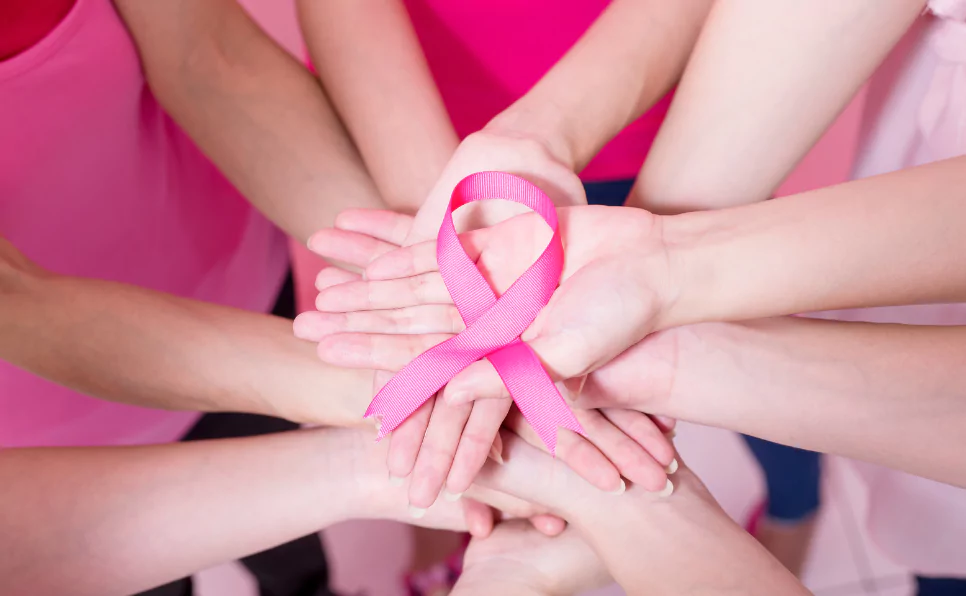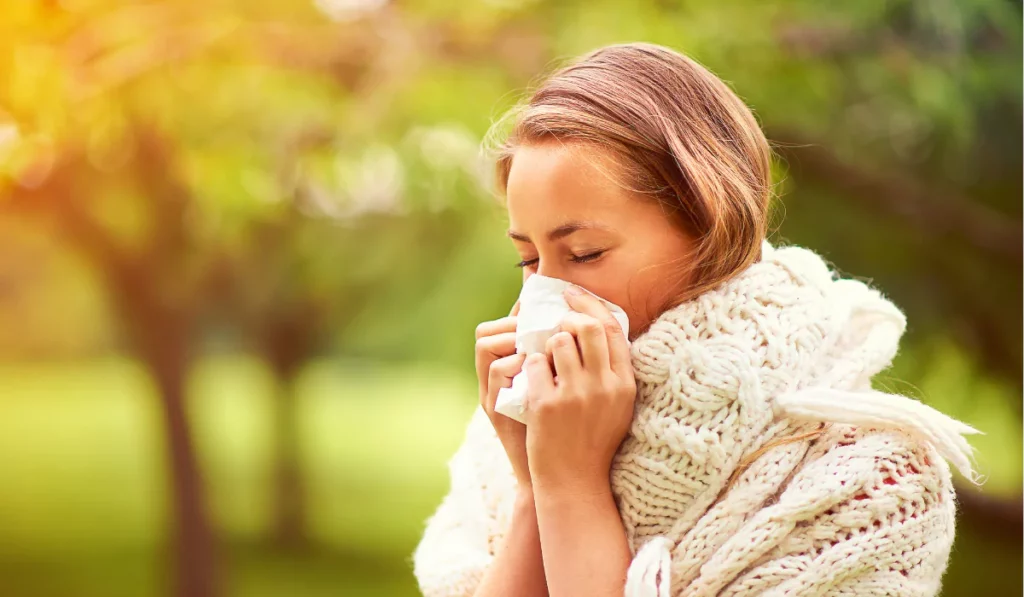Breast cancer affects countless women globally. It happens when cells in the breast grow out of control, forming a tumor that can invade nearby tissues or spread throughout the body.
Various factors, including age, lifestyle, hormones, and genetics or “genes”, can contribute to breast cancer.
Genes are like instruction manuals in our DNA, which guide the building of proteins that our cells need to function. But, sometimes, genes can change or mutate, disrupting their normal function and leading to diseases such as cancer.
In this article, we’ll break down the basics of breast cancer, including its symptoms and its genetic causes. We’ll also explore how genetic testing can identify those with a higher risk of developing breast cancer and ways to prevent or treat it.
Understanding the Basics of Breast Cancer
Breast cancer is a cancer that starts in the breast tissue. The breast is composed of three main parts: the lobules (milk-producing glands), the ducts (tubes carrying milk to the nipple), and the connective tissue that holds everything together.
It can start anywhere in the breast but is mainly found in the ducts or lobules. The cancer cells’ appearance under a microscope can classify breast cancer into different types, like ductal carcinoma (cancer that begins in the ducts), lobular carcinoma (cancer that begins in the lobules), or other less common types.
Breast cancer is also classified by its stage, which shows how far it has spread within the breast or to other body parts. Stages range from 0 to 4, with higher numbers indicating more advanced disease. Stage 0 means the cancer is confined to the ducts or lobules, while stage 4 means it has spread to distant organs.
Breast cancer is among the most common cancers in women globally. According to the World Health Organization (WHO), in 2020, there were 2.3 million new cases and 685,000 deaths from breast cancer. It affects women of all ages but is more common in older women (over 40 years) and those with certain risk factors.
Symptoms of Breast Cancer
Early-stage breast cancer may not show any symptoms. However, as it grows and spreads, it may cause changes in the breast or other signs. Some of these symptoms include:
- A new lump or mass in the breast or underarm area
- Changes in the size, shape, or appearance of the breast
- Changes in the breast skin, such as dimpling, puckering, redness, scaling, or thickening
- Changes in the nipple, such as inversion, discharge, or irritation
- Pain or tenderness in the breast
- Swelling or lymph nodes in the armpit or collarbone area

These symptoms don’t necessarily mean that a person has breast cancer, as other benign conditions, such as cysts, infections, or hormonal changes, could cause them. However, seeing a doctor if any of these symptoms persist or worsen over time is crucial.
Genetics of Breast Cancer
Genetics plays a crucial role as the primary underlying cause of breast cancer influencing an individual’s susceptibility to the disease. The combination of sporadic mutations, occurring spontaneously during one’s lifetime, and inherited mutations passed down through generations, collectively contributes to approximately 90% to 95% of all diagnosed breast cancer cases. These mutations, whether inherited or acquired, disrupt normal cellular processes, leading to the initiation and progression of breast cancer.
How It Happens?
Genes are segments of DNA that contain instructions for making proteins. Proteins perform various functions in our cells, like regulating growth, repair, communication, and defense.
Some proteins, like tumor suppressors, prevent cells from growing out of control and becoming cancerous, while others, like oncogenes, promote cell growth and division.
Sometimes, genes can change or mutate, altering their normal function.
These mutations can be inherited from our parents (germline mutations) or acquired during our lifetime (somatic mutations).
Germline mutations are present in every cell of our body and can increase our risk of developing certain cancers. Somatic mutations only occur in some cells and can cause them to become cancerous.
Both germline and somatic mutations can cause breast cancer. However, most breast cancer cases are sporadic, meaning they’re not inherited and result from somatic mutations accumulating over time due to aging, environmental factors, or random DNA replication errors.
Is Breast Cancer Hereditary?
Hereditary breast cancer, caused by germline mutations passed down through generations, constitutes only 5 to 10% of cases. Predominantly, mutations in BRCA1 and BRCA2 drive this hereditary form, elevating the risk of breast, ovarian, prostate, and pancreatic cancers. Carriers of BRCA1 or BRCA2 mutations face a 50 to 85% lifetime breast cancer risk, contrasting sharply with the general population’s 12% risk.
Other genes like TP53, PTEN, PALB2, and CHEK2 also play roles in hereditary breast cancer susceptibility. However, these genes are less common and account for a smaller proportion of hereditary breast cancer cases.
Men who inherit a mutation in BRCA1 or BRCA2 also have an increased risk of developing breast cancer, but it’s much lower than for women (about 1 to 10%).
We often hear the question: “Is breast cancer familial?” The answer is both yes and no.
So, Does Breast Cancer Run in Families?
If we look at families where breast cancer seems to “run in the family”, it’s often because one or more family members have a mutation in one of these genes. But, not all breast cancers are due to these inherited gene mutations. In fact, most are not as we discussed earlier.
Most cases of breast cancer happen randomly, without a clear reason. These are often due to changes in our genes that happen during our lifetime rather than being passed down from our parents.
These gene changes can be due to things like aging or exposure to certain things in the environment.
Now, if your mom had breast cancer, or if breast cancer runs in your family, it does not mean you will definitely get breast cancer. It just means your chances are higher.
If you’re worried about your family history of breast cancer, you can get a test to check your genes.
While the genetics of breast cancer is important, there are other things that can increase your chance of getting breast cancer.
Some of these are things you can change, like smoking or drinking too much alcohol, not getting enough exercise, or being overweight. Eating a healthy diet can help lower your risk of breast cancer.
Other things you can’t change, like getting older or starting your period at a young age, can also increase your risk.
Sometimes, stuff around us, like certain chemicals or radiation, can also increase our risk of breast cancer. So while family history plays a part, lifestyle, and environment are also very important.
Understanding the Role of Genes in Breast Cancer
There are two main types of genes that can influence cancer: tumor suppressor genes and oncogenes. If mutations happen in these genes, they can cause cells to grow out of control, which may lead to cancer.
How Do Genetic Mutations Cause Cancer?
Cancer is a disease that happens when cells grow out of control, forming tumors that can invade nearby tissues or spread to other parts of the body.
Genetic mutations can lead to cancer by affecting genes that regulate cell growth and division. Two main types of these genes exist: tumor suppressor genes and oncogenes.
- Tumor suppressor genes normally stop cells from growing out of control and becoming cancerous. They repair DNA damage, halt cell division when there’s an error, or trigger cell death (apoptosis) when the damage is too severe. When mutations occur in these tumor suppressor genes, they can lose their function, allowing cells to gather more mutations and become malignant.
- Oncogenes, on the other hand, normally promote cell growth and division. They create proteins that stimulate the progression, survival, and proliferation of the cell cycle. Mutations in oncogenes can enhance their function, leading cells to grow faster and more aggressively.
The relationship between genetic mutations and cancer’s aggressiveness depends on several factors, such as the type, number, location, and timing of the mutations. More mutations typically lead to more aggressive cancers that are harder to treat.
However, some mutations can also make cancers more sensitive to specific therapies, like targeted drugs that block specific proteins or pathways.
Genetic Testing For Breast Cancer
Genetic testing can reveal hidden risks of certain diseases like cancer. So, when we ask, “Is breast cancer genetic?”, genetic testing can provide the answer.
It identifies those who might be predisposed or more likely, to get the disease due to their genes, which may lead to more surveillance, prevention, and personalized treatment strategies.
Still, not everyone needs this test. It’s usually suggested for those who have a personal or family history that points to a higher risk of having genes for breast cancer.
Some red flags include being diagnosed with breast cancer before turning 50, having ovarian cancer at any age, a male relative with breast cancer, multiple relatives with breast or ovarian cancer on the same side of the family, relatives with both breast and ovarian cancer, relatives with rare cancers linked to BRCA1 or BRCA2 mutations (like prostate, pancreatic, or melanoma), or having Ashkenazi Jewish ancestry with a family history of breast or ovarian cancer.
The genetic testing procedure is relatively simple. It involves taking a blood, saliva, or tissue sample from the person being tested. This sample is then sent to a lab where scientists look for specific mutations in the DNA and share the results with the person’s doctor or genetic counselor.
Results of genetic testing
The results of the test can be positive, negative, or uncertain. A positive result means a mutation was found in a breast cancer susceptibility gene, indicating an increased risk of the disease. But it doesn’t mean you will definitely develop breast cancer or that it can’t be prevented or treated.
A negative result means no mutation was found in a breast cancer susceptibility gene. This suggests that your genetics don’t predispose you to breast cancer due to the genes that were tested. But it doesn’t mean you’re completely safe from the disease or that a mutation isn’t hiding in another untested gene.
An uncertain result means they found a mutation, but its effect on your breast cancer risk isn’t clear. This usually happens when the mutation is rare or hasn’t been well studied. Further research may be needed to understand these mutations.
The benefits of genetic testing for breast cancer include knowing your risk, making informed healthcare decisions, enabling early detection, and improving survival rates.
But it’s not perfect. It can’t detect all mutations or genes causing breast cancer and can’t predict with absolute certainty if or when a person will develop the disease. Moreover, it can bring up psychological, emotional, social, or ethical challenges. Therefore, think carefully and talk to a doctor or genetic counselor before deciding to get tested.
Other Factors That Can Influence Breast Cancer Risk
Genetics of breast cancer isn’t the only factor that determines the risk of developing the disease. Lifestyle, hormones, and environment also play a part. Some can be modified or avoided, while others cannot.
Lifestyle factors
Lifestyle factors like diet, obesity, physical inactivity, alcohol consumption, and smoking can increase the risk of breast cancer.
Eating a balanced diet rich in fiber, fruits, vegetables, whole grains, and antioxidants, maintaining a healthy weight, staying physically active, limiting alcohol intake, and not smoking can all reduce the risk.
Hormonal and reproductive factors
Hormonal and reproductive factors can also increase the risk of breast cancer. These relate to how long a person’s body is exposed to estrogen and progesterone hormones.
This exposure can be extended by early menstruation or late menopause. Hormone replacement therapy and contraceptive use can also affect hormone levels in the body, increasing the risk.
Environmental factors
Lastly, environmental factors like radiation exposure and contact with endocrine disruptors and carcin
ogens (chemicals that can interfere with hormones or cause cancer) can also increase the risk of breast cancer. Examples of these include pesticides, PCBs, BPA, phthalates, dioxins, and tobacco smoke.
Remember, a family history of breast cancer, or familial breast cancer, does increase risk, but lifestyle and environmental factors also play a significant role. By understanding and addressing these, you can help reduce your risk even if breast cancer runs in your family.
Treatment Options for Breast Cancer
When someone has breast cancer, doctors can try to get them better in many ways. What kind of treatment is used can depend on a lot of things.
Some of these things are how big the cancer is, where it is, if it has spread to other parts of the body, and how healthy the person is.
Surgery
One way to treat breast cancer is by using surgery. This means a doctor cuts out the cancer. Sometimes they might take out some extra tissue around the cancer to make sure they get it all. There are a couple of ways to do this.
- Lumpectomy: This is when the doctor takes out the cancer and a little bit of the normal tissue around it. This means the person can keep most of their breast. After this kind of surgery, the person usually has radiation therapy. This is to kill any cancer cells that might be left.
- Mastectomy: This is when the doctor takes out the whole breast. Sometimes after this kind of surgery, the person might choose to have another surgery to make a new breast. This is called breast reconstruction.
Sometimes the doctor might also take out some lymph nodes from under the arm. Lymph nodes are small, bean-shaped parts of the body that help fight infection.
If the cancer has spread, it often goes to the lymph nodes first. Doctors can see if the cancer has spread by taking them out and looking at them under a microscope.
Radiation Therapy
Another way to treat breast cancer is with radiation therapy. This uses high-energy rays to kill cancer cells.
Patients might have this after surgery to kill any cancer cells that might be left. Sometimes a patient might have it before surgery to make big cancer smaller and easier to take out.
Chemotherapy
Chemotherapy is a kind of medicine that kills cancer cells. Patients might have this before surgery to make the cancer smaller. Or they might have it after surgery to kill any cancer cells that might be left.
Chemotherapy can also help when the cancer has spread to other parts of the body.
Hormone Therapy and Targeted Treatments
Some breast cancers grow faster when there are certain hormones in the body. Hormone therapy is a kind of medicine that stops these hormones from helping the cancer grow.
There are also medicines that can find and kill only the cancer cells. These are called targeted treatments. These can be really helpful if the cancer has a certain thing on the surface of its cells or a certain kind of gene.
It’s important to remember that everyone is different. So, what works best for one person might not work best for another. That’s why doctors carefully examine each person’s cancer before deciding what kind of treatment is best.
Prevention of Breast Cancer: The Role of Genetics and Lifestyle
Acting to lessen the odds of getting breast cancer is what we call breast cancer prevention.
Both genetic makeup and how you live your life can change your odds. Some things that might make you more likely to get breast cancer, like having it in your family or having certain gene changes, are things you can’t alter.
But you can change some things in your life, like what you eat, how much you exercise, and if you drink alcohol or use tobacco. It’s also vital to get regular check-ups and to catch breast cancer early to help prevent it.
How Your Genes Can Affect Prevention
Your genetic makeup plays a big part in your breast cancer risk. Some women have gene changes passed down from their parents that make it more likely they’ll get breast cancer.
The gene changes that usually go hand in hand with breast cancer are BRCA1 and BRCA2.
Women who have a lot of breast cancer in their family or who think they might have a BRCA1 or BRCA2 gene change could benefit from getting genetic advice and testing. This can help them understand how likely they are to get breast cancer and what they can do to prevent it and get screened.
A gene test can confirm if they have a BRCA1 or BRCA2 gene change or another gene change that makes them more likely to get breast cancer.
Women who have a BRCA1 or BRCA2 gene change or another high-risk gene change can take steps to lessen their chance of getting breast cancer. These steps include:
- Surgery to prevent cancer: This includes removing the breasts (a preventative mastectomy) or the ovaries and fallopian tubes (preventative salpingo-oophorectomy) before cancer shows up. Surgery to prevent cancer can greatly lessen the chances of getting breast and ovarian cancer, but it doesn’t get rid of the chance completely. It also has physical and emotional effects that need careful thought.
- Medicine to prevent cancer: This involves taking drugs that block or reduce the impact of estrogen on breast tissue. Estrogen is a hormone that makes some types of breast cancer cells grow. Medicine to prevent cancer can include drugs like tamoxifen or raloxifene, which block estrogen receptors on breast cells, or aromatase inhibitors, which reduce the amount of estrogen made in women who have gone through menopause. Medicine to prevent cancer can lower the chance of getting breast cancer by about 50%, but it also has side effects and risks that need to be weighed against the benefits.
- Gene therapy: This is a new field of research that aims to correct or replace faulty genes that cause disease. Gene therapy to prevent breast cancer could involve introducing normal copies of BRCA1 or BRCA2 genes into breast cells or using gene editing techniques to fix the changed genes. Gene therapy to prevent breast cancer is still being researched and hasn’t been tested in humans yet.
Changes You Can Make in Your Life
How you live your life can also affect your chance of getting breast cancer. Some things you can do to lower your risk include:
- Eating well: A healthy diet full of fruits, vegetables, whole grains, legumes, nuts, and healthy fats can help prevent breast cancer. These foods provide antioxidants, phytochemicals, fiber, vitamins, minerals, and other nutrients that protect against DNA damage and inflammation. Eating well can also help you keep a healthy weight, which lowers your chance of getting breast cancer.
- Exercise: Keeping active can help prevent breast cancer by improving blood circulation, immune function, hormone balance, metabolism, and body composition. Physical activity can also lower stress and improve mood and quality of life. The American Cancer Society suggests adults get at least 150 minutes of moderate-intensity or 75 minutes of vigorous-intensity physical activity per week, spread throughout the week.
- Limiting alcohol: Drinking alcohol can raise your chance of getting breast cancer by raising estrogen levels, damaging DNA, messing with folate metabolism, and increasing oxidative stress. The more alcohol you drink, the bigger your chance of getting breast cancer. The American Cancer Society suggests women have no more than one drink a day.
- Avoiding tobacco: Smoking tobacco can raise your chance of getting breast cancer by introducing carcinogens, damaging DNA, harming immune function, and increasing inflammation. Smoking can also raise your chance of getting other types of cancer and chronic diseases. The best way to prevent breast cancer and other health problems caused by tobacco is to never start smoking or to quit if you are a smoker.
Regular Check-ups and Catching It Early
Regular check-ups and catching breast cancer early are key to preventing it. Check-ups are tests done to look for breast cancer before any symptoms show up. Catching it early means finding breast cancer as soon as possible, when it’s easier to treat and has a better chance of being cured.
The most common test for breast cancer is a mammogram, which is an X-ray of the breast that can show abnormal areas or lumps.
The American Cancer Society suggests that women aged 40 to 44 should choose to start annual mammograms if they want to, women aged 45 to 54 should get mammograms every year, and women aged 55 and older should switch to mammograms every 2 years or keep getting them yearly.
Other tests for breast cancer include a clinical breast exam, when a health care provider checks the breast, and a breast self-exam when you check your own breasts for any changes or signs of breast cancer.
The American Cancer Society doesn’t suggest regular clinical breast exams or breast self-exams as tests for breast cancer, but it does encourage women to know their breasts and to tell their healthcare provider about any changes.
Women who are more likely to get breast cancer, like those who have a BRCA1 or BRCA2 gene change or a lot of breast cancer in their family, may need more check-ups or stronger tests, like magnetic resonance imaging (MRI) or ultrasound, in addition to mammograms. Women who have a high risk of getting breast cancer should talk with their healthcare provider about their testing options and schedule.
Living With Breast Cancer: Help and Information
Living with breast cancer can be tough and stress-inducing. It not only influences your physical well-being but also impacts your emotions, your relationships, your job, your financial situation, and how you enjoy life. Hence, it’s crucial to find help and resources to deal with the effects of breast cancer on your life.
Emotions and mental health aspects
Breast cancer can stir up various emotions, such as fear, worry, sadness, anger, guilt, feeling alone, or even depression. It’s natural and understandable to feel this way when dealing with a serious illness. However, if these feelings start messing with your daily life or become too much to handle, you might need professional help to deal with them.

Here are some ways to deal with the emotional and mental parts of breast cancer:
- Getting counseling or therapy: Speaking with a mental health expert, like a psychologist, psychiatrist, social worker, or counselor, can help you voice your feelings, handle stress, adapt to changes in your life, and find solutions to issues. Your health care provider, insurance company, or online directories can help you find a mental health expert.
- Joining a support group: Being part of a support group can help you connect with others who are facing similar experiences and difficulties with breast cancer. You can share your experiences, feelings, advice, and resources with others who know what you’re dealing with. Your healthcare provider, local hospital or clinic, or online platforms can help you find a support group.
- Practicing relaxation methods: Doing activities that relax your body and mind can help you reduce stress and improve your mood. Deep breathing, meditation, yoga, tai chi, massage therapy, aromatherapy are some examples of relaxation techniques.
Final Words
Breast cancer is the most frequently diagnosed cancer in women around the world and the second main cause of cancer-related death. It’s a complicated and varied disease influenced by numerous factors like genetics, lifestyle, and environment.
Understanding breast cancer’s genetics can help pinpoint women with a high risk of developing the disease and provide them with prevention options like genetic testing, preventive surgery, or medication.
Early detection of breast cancer can also improve survival chances and lessen the need for harsh treatments. Prevention and screening strategies for breast cancer can differ based on a person’s risk factors, preferences, and resources.
Breast cancer is not a hopeless disease but a challenge that can be conquered with knowledge, courage, and support.
References:
- https://www.who.int/news-room/fact-sheets/detail/breast-cancer
- https://www.britannica.com/science/breast-cancer
- https://www.cdc.gov/cancer/breast/basic_info/what-is-breast-cancer.htm
- https://pubmed.ncbi.nlm.nih.gov/25605744/
- https://www.cancer.gov/types/breast/hp/breast-ovarian-genetics-pdq
- https://www.nejm.org/doi/full/10.1056/NEJMoa1913948
- https://pubmed.ncbi.nlm.nih.gov/18544032/
- https://www.mayoclinic.org/diseases-conditions/breast-cancer/diagnosis-treatment/drc-20352475
- https://www.cancer.org/cancer/types/breast-cancer/screening-tests-and-early-detection.html
- https://www.mayoclinic.org/diseases-conditions/breast-cancer/diagnosis-treatment/drc-20352475
- https://www.cancer.net/cancer-types/breast-cancer/types-treatment
- https://www.cancer.org/cancer/types/breast-cancer/treatment/treatment-of-breast-cancer-by-stage.html
- https://www.cancerresearchuk.org/about-cancer/breast-cancer/treatment
- https://www.mayoclinic.org/healthy-lifestyle/womens-health/in-depth/breast-cancer-prevention/art-20044676
- https://www.cancer.gov/types/breast/patient/breast-prevention-pdq
- https://www.ncbi.nlm.nih.gov/pmc/articles/PMC9465273/
- https://www.ncbi.nlm.nih.gov/pmc/articles/PMC8428369/
- https://www.ncbi.nlm.nih.gov/pmc/articles/PMC8966510/
- https://pubmed.ncbi.nlm.nih.gov/29493913/
- https://pubmed.ncbi.nlm.nih.gov/31277273/
- https://www.ncbi.nlm.nih.gov/pmc/articles/PMC4478970/
- https://www.breastcancer.org/risk/risk-factors/genetics
- https://www.nationalbreastcancer.org/breast-cancer-genetics/

Dr. Sumeet is a seasoned geneticist turned wellness educator and successful financial blogger. GenesWellness.com, leverages his rich academic background and passion for sharing knowledge online to demystify the role of genetics in wellness. His work is globally published and he is quoted on top health platforms like Medical News Today, Healthline, MDLinx, Verywell Mind, NCOA, and more. Using his unique mix of genetics expertise and digital fluency, Dr. Sumeet inspires readers toward healthier, more informed lifestyles.





